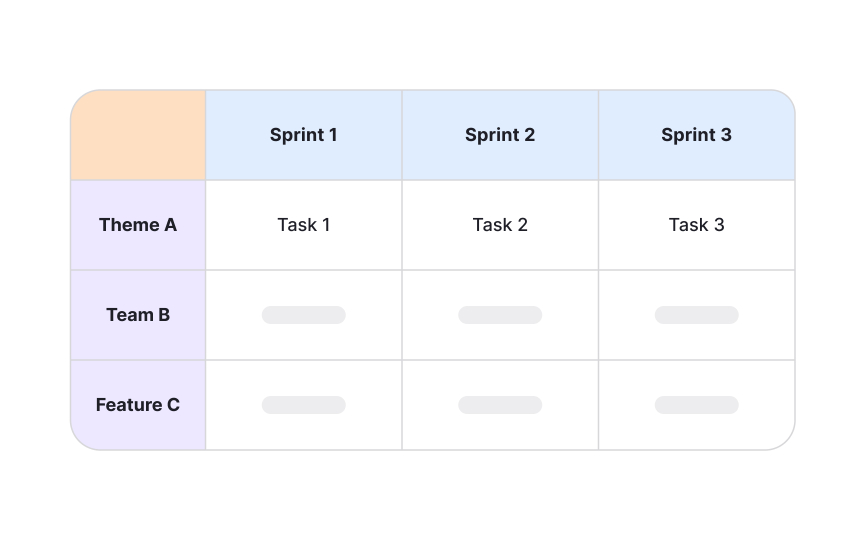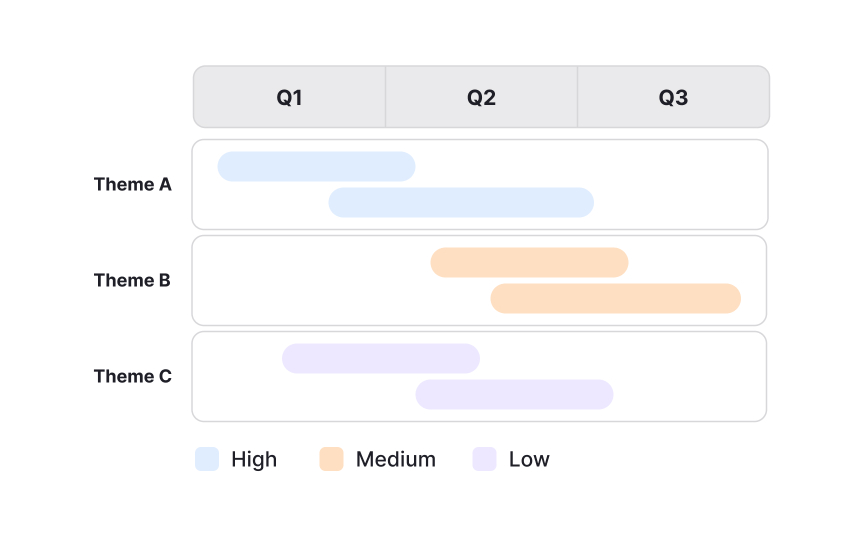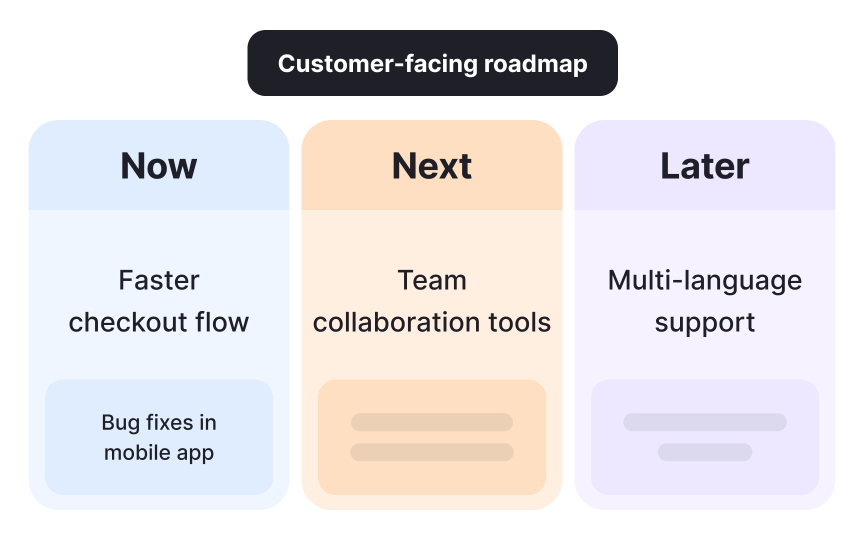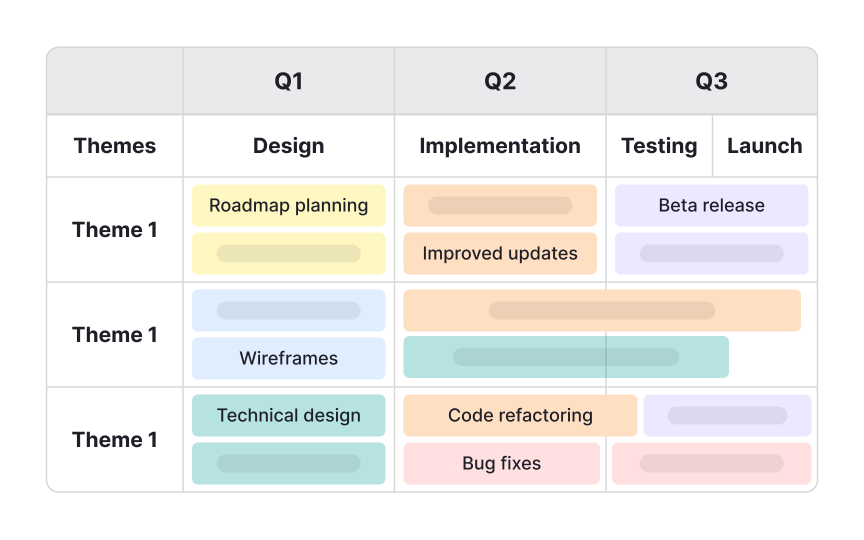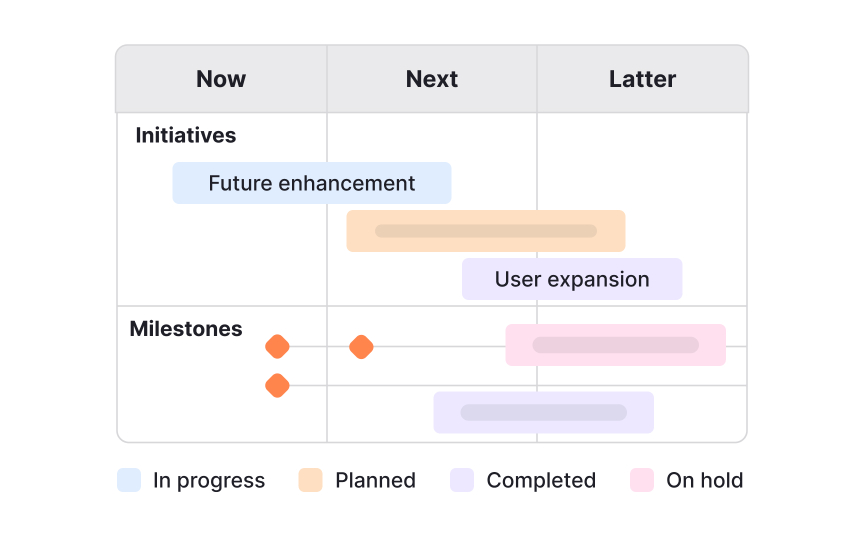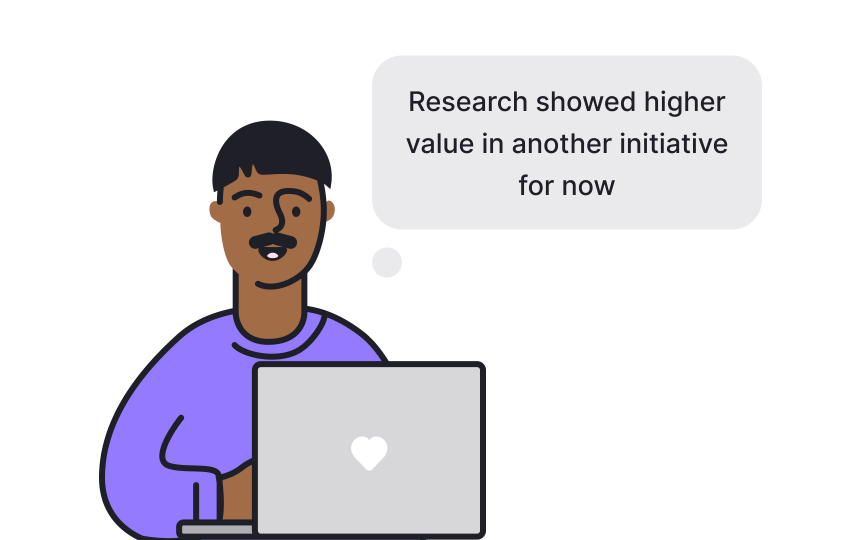Communicating and Socializing Your Roadmap
Turn your roadmap into a clear, adaptable message that resonates with every audience.
A roadmap is not only a planning tool but also a way to shape understanding across the organization. The same roadmap must often be seen in different ways: executives want a high-level strategic view, engineers need clarity on sequencing and dependencies, and sales or customers require a simplified version that emphasizes direction and value.
Communicating effectively means tailoring each version, choosing visuals that clarify instead of clutter, and delivering the message in a way that sparks engagement. Pitfalls such as overloading with detail, vague timelines, or static designs can quickly weaken impact. Clear design, confidence markers, and regular updates help ensure that the roadmap stays relevant.
Concise and transparent presentation is critical. Executives are busy and want to know what matters most, while sales teams need simple narratives to share with clients. Objections and questions are inevitable, so anticipating them and preparing evidence to support decisions keeps the conversation productive. By combining strategic tailoring with visual clarity and proactive communication, product managers can make the roadmap a shared language that aligns all stakeholders.
A single roadmap cannot satisfy the needs of all stakeholders in the same form. Each audience looks for different signals and levels of detail. Development teams need to see specifics such as sequencing of features, dependencies between tasks, and technical milestones that guide their delivery. At the same time, they do not need high-level portfolio overviews or broad company objectives, since those do not help them organize their daily work.
Sales teams, by contrast, need a simplified version that highlights the product direction, expected release windows, and customer-facing improvements. Internal details such as confidence levels, unresolved technical debt, or uncertain long-term items should be left out, as these create confusion or risk false promises in client conversations. What should remain are the themes and
By adjusting what is shown and what is removed, the roadmap becomes a set of consistent but focused views. Each version is built on the same underlying plan, but it highlights different information depending on the audience. This ensures relevance for those who use it without creating misalignment across the organization.
Executives expect a roadmap that highlights the product’s direction at a strategic level. They look for themes, milestones, and links to company goals rather than a breakdown of individual features. Including too much detail can distract from the bigger picture and lead to unproductive discussions about specific tasks. A concise view with clear priorities helps keep attention on what drives the business forward.
Certain elements should be intentionally left out. Detailed engineering dependencies, sprint-level planning, and speculative features are not relevant to an executive audience. Overly long timelines are also problematic, since forecasts far beyond nine to twelve months are rarely accurate and can create a false sense of certainty. Instead, executives should see a limited horizon with high-level
Clarity about certainty is essential. Each roadmap item can be marked according to how confident the team is about its delivery. For example, features already in development may be shown with a high-confidence label, while longer-term initiatives can be marked as medium or low confidence. Using color codes or simple legends prevents executives from interpreting the entire roadmap as guaranteed. This distinction makes it easier to separate near-term commitments from longer-term possibilities and keeps expectations realistic.
A customer-facing roadmap needs to show direction and value without exposing the internal complexities of product development. Its purpose is to build trust and create confidence that the product is evolving in ways that matter to users. This means highlighting improvements, upcoming features, or themes that directly relate to customer needs rather than company-specific priorities.
Customers do not need to see
Promising exact dates or presenting uncertain items as firm commitments can lead to frustration if plans change. A better approach is to group items into time horizons such as “Now,” “Next,” and “Later,” or to provide broad delivery windows. This communicates progress without locking the team into commitments that cannot be guaranteed. By balancing transparency with restraint, the customer-facing roadmap reinforces credibility and strengthens the relationship with users.
Visual roadmaps make complex information easier to understand at a glance. Instead of long text lists or static spreadsheets, they use timelines, themes, icons, and colors to show how
The format chosen should match the purpose. Timelines work well for high-level strategic planning, while swimlanes or Kanban views can support cross-team coordination. Adding milestones, initiatives, and dependencies with simple markers helps keep the roadmap practical.
Poor visualization can have the opposite effect. Overloading the roadmap with too many icons or details can overwhelm the audience, while vague or inconsistent timelines create confusion. To avoid this, visual elements should be used to emphasize clarity, not decoration. A well-visualized roadmap keeps the focus on priorities and allows stakeholders to quickly see where the product is heading.
Pro Tip: Use visuals to clarify priorities, not to decorate. Simplicity makes the roadmap easier to follow.
Many roadmaps fail not because of strategy but because of poor communication choices. Common pitfalls include:
- Too much detail. Overloading the roadmap with minor tasks or dense descriptions hides the central message and overwhelms the audience.
- Vague or inconsistent timelines. When timing is unclear, it becomes difficult to judge progress and the roadmap loses credibility.
- Unsuitable visualization tools. Choosing a format or platform that does not fit the team’s workflow makes the roadmap harder to maintain and reduces its usefulness.
- Lack of updates. A roadmap that quickly becomes outdated no longer reflects reality and stops being trusted as a planning tool.
- Limited stakeholder input. Excluding perspectives from engineering, marketing, or leadership leaves out critical priorities and weakens alignment.
Avoiding these pitfalls means focusing on clarity, accuracy, and inclusion. A roadmap should contain only the most important elements for its audience, use clear timeframes, and be reviewed regularly. Inviting feedback from key stakeholders ensures that the roadmap remains relevant and reflects shared goals. With these practices, the roadmap becomes a reliable guide instead of a misleading or abandoned artifact.[2]
Pro Tip: Keep the roadmap updated and focused. Outdated or overloaded roadmaps lose trust and reduce alignment.
An effective roadmap presentation is short and focused. Executives and other stakeholders have limited time and expect to see what matters most. The roadmap should highlight strategic priorities, upcoming milestones, and the value each
The scope should also be carefully limited. A common practice is to present a view of the next nine to twelve months, since forecasts beyond that period are highly likely to change. Exceptions exist for industries like hardware or enterprise systems that require longer planning horizons, but even there, clarity is more important than precision. Keeping the presentation concise makes it easier for stakeholders to stay engaged and aligned.
Conciseness does not mean oversimplification. Supporting materials can be prepared in case deeper questions arise. The goal is to keep the primary view clear and high level, while having backup information ready if stakeholders need details. This approach balances efficiency with transparency and avoids overwhelming the audience with unnecessary data.
Pro Tip: Keep the core presentation brief, but prepare backup details for questions that may arise.
Not all items on a roadmap carry the same level of confidence. Work in progress is usually reliable, but
One way to show certainty is by grouping initiatives into categories such as high, medium, and low confidence. For example, items currently in development can be marked as high confidence, while those planned for the next quarter may be medium, and longer-term ideas may be low. Visual markers such as
This approach ensures that roadmaps communicate both direction and uncertainty in a balanced way. Stakeholders gain a clear view of what is already underway and what may still change. By separating commitments from possibilities, the roadmap builds trust and makes conversations about risk and priority more productive.
Roadmap discussions often bring up difficult questions from executives or stakeholders. Common objections include concerns about why a release is delayed, why resources are being spent on internal improvements instead of new features, or why an anticipated
The best way to manage objections is to prepare for them in advance. If a release includes significant
Clarity and evidence are essential in these conversations. Instead of avoiding the objection or giving vague answers, provide supporting data such as adoption rates, revenue impact, or
A roadmap quickly loses value if it is not refreshed. Stakeholders rely on it to understand direction, so when it becomes outdated, trust is weakened and alignment suffers. Because product work changes rapidly, roadmaps must be reviewed and updated on a regular basis rather than treated as a one-time plan.
The frequency of updates depends on the type of product and the team’s operating rhythm. Agile teams working in short iterations may review and adjust their roadmap monthly or even more often. Teams with longer release cycles, such as hardware or complex enterprise systems, may update quarterly. The important point is that the roadmap reflects the current state of priorities and is revised whenever significant shifts occur.
Each update should be communicated clearly to stakeholders. Sharing changes in direction, new risks, or revised timelines ensures that everyone works with the same information. This practice not only keeps the roadmap accurate but also builds confidence that it remains a living document connected to reality rather than a static chart that fades into irrelevance.
References
Topics
From Course
Share
Similar lessons

Roadmaps and Prioritization

Why You Need a Roadmap

